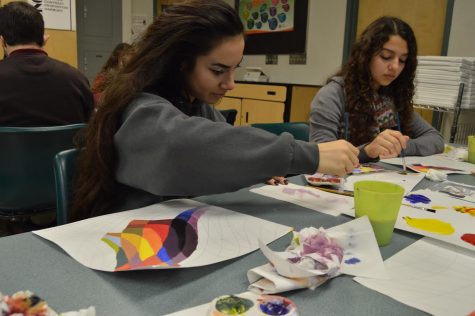Behind the scenes of AP Art
February 17, 2015
m “I’ve been drawing since I was little and I have wanted to take [AP Studio Art] since freshmen year,” said senior Ainsley Dye. Dye is very passionate about art, so AP Studio Art was a class that she sought as a necessity. Getting accepted in the class was a somewhat difficult thing for Dye to do, as she had to submit a portfolio of her best art to AP Studio Art teacher Nyrie Gharibian.
While students still have to get recommended by an art teacher, the most important thing is having a portfolio to present to Gharibian. Portfolios are important to art students, as they are collections of their best work and can be the winning ticket to getting accepted into an art college or in this case, AP Studio Art.
Not only is the portfolio key to getting accepted into AP Studio Art, but it is also the student’s AP exam. AP Studio Art does actually have an exam like other AP classes, but the exam is to turn in the portfolio to judges, “who evaluate creativity and meeting specific requirements,” according to Dye.
There is no specific topic that judges want the students to draw or design; they just want to see the student’s best work. Portfolios must have art pieces that concentrate on breadth and focus. Breadth is a standard project such as still life and figure drawing and focus projects are personal projects that students wish to work on.
AP students must work extremely hard throughout the year, according to Gharibian. The portfolio they submit to judges for the exam is completely different from the one they submit to colleges. They can use the same paintings, drawings or any works of art in both portfolio; however, the portfolio that is turned in must consist of 24 works. Half of the works focus on breadth and the other half deal with focus or concentration works. Overall, five out of all those works will be judged on its quality. This amount of work shows that in this class hard work is a major factor.
The class may seem unorthodox, meaning students don’t sit down for 90 minutes taking notes and listening to a lecture; instead they immediately work on whatever project they have to finish. In addition, Gharibian gives the students assignments which they must finish as they also work on their own projects.The class has a different atmosphere than other classes. Senior Timothy Suh says, “I really enjoy the class, but not just because I like art but because the class has a free environment.”

Art student sophomore Marida Torosyan works on an assignment with water color.
Gharibian individually meets with her students to help them find their artistic voice in order to help them with their artwork. “This method is useful because I can help students by telling them whether they are using a technique correctly or incorrectly,” Gharibian said. “Also, I can help them find the voice or the theme of their project, because sometimes they don’t see they use a recurring theme.”
Students quickly learn to juggle between finishing assignments and working on their own projects. “The good thing about this class is that it teaches you time management,” said senior Eric Supangan. ”How much time a student works on a project is important because Ms. Gharibian grades her students’ work based on its quality, just as the judges do during the AP exam.
Dye said she likes how the class allows her to be “able to showcase individual voices in an artistic way.” Supangan said he likes “expressing creativity and experimenting with different mediums” and Suh said he likes the “free environment and really friendly atmosphere.” However, putting off work even for a couple minutes is a luxury that students in AP Studio Art cannot afford.
A unique aspect of the class is that the students don’t get the exact same assignment. Some prefer design, meaning they work on computers and use programs such as Adobe Illustrator and Photoshop. Others prefer to draw, paint and use different kinds of tools to express their creativity. This is why grading system for a class like this is judging the quality and how much time and effort the student put into it, according to Supangan.
Students take this class for many reasons. Suh said he took the class for several purposes. “I took the class because it will help me in college, also for the experience, and earn people’s critique,” Suh said. Taking certain AP classes can show what students want to be in the future. AP Studio Art students can major in a wide variety of majors that lead to many different careers such as architecture, studio art, art history, illustration, fine arts and entertainment.
Because students do get college credit if they pass the AP exam, this of course will come in handy for the few seniors who take the class and wish to continue a career in art by applying to art colleges. There are many fine arts colleges in the nation such as School of Art Institute: Chicago (SAIC), Otis College Art and Design, Rhode Island School of Design (RISD), and Burnage Media Arts College (BMAC).
“This class helps young artists discover their artistic voices,” Dye said.
